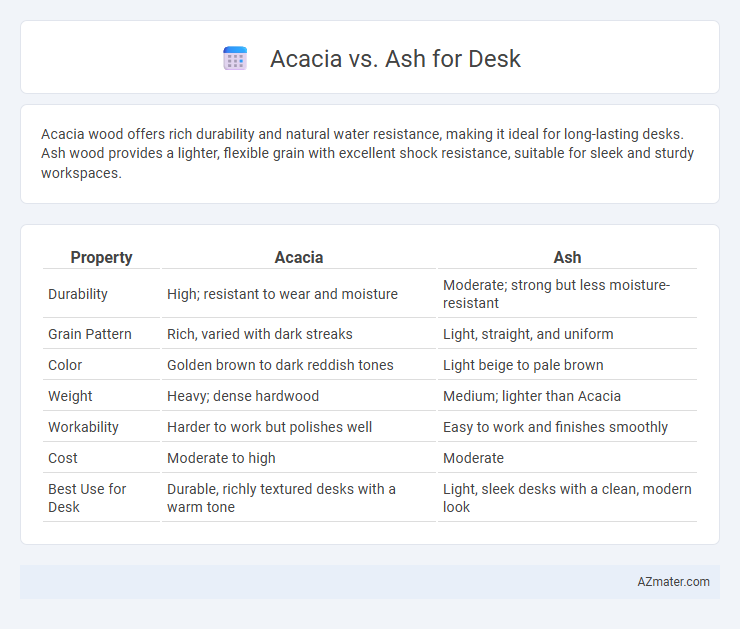Acacia wood offers rich durability and natural water resistance, making it ideal for long-lasting desks. Ash wood provides a lighter, flexible grain with excellent shock resistance, suitable for sleek and sturdy workspaces.
Table of Comparison
| Property | Acacia | Ash |
|---|---|---|
| Durability | High; resistant to wear and moisture | Moderate; strong but less moisture-resistant |
| Grain Pattern | Rich, varied with dark streaks | Light, straight, and uniform |
| Color | Golden brown to dark reddish tones | Light beige to pale brown |
| Weight | Heavy; dense hardwood | Medium; lighter than Acacia |
| Workability | Harder to work but polishes well | Easy to work and finishes smoothly |
| Cost | Moderate to high | Moderate |
| Best Use for Desk | Durable, richly textured desks with a warm tone | Light, sleek desks with a clean, modern look |
Introduction to Acacia and Ash Wood
Acacia wood is a dense, durable hardwood known for its rich, warm tones and natural resistance to moisture and wear, making it ideal for long-lasting desks. Ash wood features a lighter color palette with prominent grain patterns, offering strength and a smooth finish that enhances desk aesthetics. Both woods provide excellent stability and durability, but Acacia's natural oils contribute to greater moisture resistance compared to Ash.
Key Characteristics of Acacia Wood
Acacia wood is prized for its high durability, rich golden-brown hues, and natural resistance to moisture, making it an excellent choice for desk construction. Its dense, tight grain and incredible hardness offer superior scratch resistance compared to ash, which tends to be lighter and softer. Acacia's natural oils help prevent warping and decay, ensuring a robust and long-lasting desk surface suitable for daily use.
Key Characteristics of Ash Wood
Ash wood is valued for its exceptional strength, durability, and light color with a distinctive grain pattern, making it ideal for desks requiring robust support and a clean aesthetic. It features excellent shock resistance and is easy to work with, lending itself well to both modern and traditional desk designs. Compared to Acacia, Ash offers a lighter tone and greater flexibility in finishing options, enhancing its appeal for customized office furniture.
Durability and Strength Comparison
Acacia wood is known for its exceptional hardness and dense grain, making it highly resistant to dents and scratches, which enhances its durability for desk surfaces. Ash wood offers superior strength with excellent flexibility and shock resistance, contributing to a sturdy and long-lasting desk structure. Comparing the two, Acacia excels in surface durability while Ash provides better overall strength and resilience under heavy use.
Aesthetic Differences: Grain and Color
Acacia wood features rich, varied grain patterns with deep golden to reddish-brown hues, offering a warm, rustic aesthetic ideal for desks aiming for natural vibrancy. Ash wood, known for its straight, uniform grain and light beige to pale brown color, provides a clean, contemporary look that suits minimalist and modern desk designs. The contrasting textures and tones between Acacia's bold, intricate grain and Ash's subtle, consistent appearance significantly influence the desk's overall visual appeal.
Sustainability and Environmental Impact
Acacia wood, prized for its durability and fast growth rate, offers a more sustainable option for desk construction compared to ash, which grows slower and is often harvested from older trees. The carbon footprint of acacia is lower due to its rapid renewability and efficient resource use, making it an environmentally favorable choice. Moreover, acacia's natural resistance to pests reduces the need for chemical treatments, enhancing its eco-friendly profile over ash wood.
Maintenance and Care Requirements
Acacia wood requires regular oiling to maintain its natural luster and prevent drying or cracking, while ash is more resistant to moisture and can withstand moderate wear with less frequent maintenance. Both woods benefit from cleaning with a soft cloth and avoiding harsh chemicals to preserve the finish and durability of the desk surface. Ash's open grain pattern may need occasional sealing to protect against stains, whereas acacia's tighter grain offers inherent resistance to scratches and dents.
Cost and Availability
Acacia wood is generally more affordable than ash, making it a cost-effective choice for desks while maintaining durability and aesthetic appeal. Ash, though often pricier, offers exceptional strength and a lighter color that many prefer for minimalist designs. Availability varies regionally, with acacia commonly sourced from tropical regions and more readily found in global markets, whereas ash is primarily native to North America and Europe, influencing its local availability and price fluctuations.
Best Applications for Acacia and Ash Desks
Acacia desks excel in durability and rich grain patterns, making them ideal for heavy-use environments like home offices and workshops where longevity and aesthetics matter. Ash desks offer a lighter color and smooth texture, perfect for modern or Scandinavian-style interiors that prioritize a bright, airy workspace. Both woods provide sturdy surfaces, but acacia is better suited for rustic or traditional decor, while ash complements minimalist and contemporary designs.
Choosing the Right Wood for Your Desk
Acacia wood offers a rich, warm tone with exceptional durability and natural resistance to scratches and moisture, making it ideal for long-lasting desks that withstand daily use. Ash wood features a lighter color and straight grain, providing a sleek, modern aesthetic while maintaining strength and flexibility, perfect for stylish yet functional desk designs. Choosing between Acacia and Ash depends on whether you prioritize a robust, textured look or a lighter, minimalist finish for your workspace.

Infographic: Acacia vs Ash for Desk
 azmater.com
azmater.com